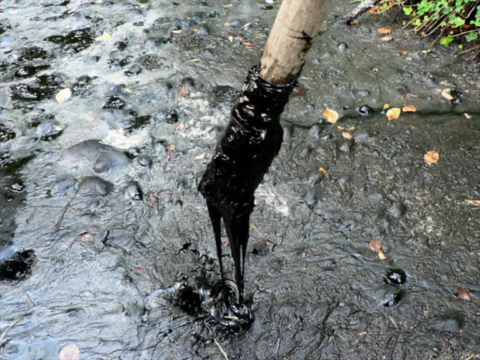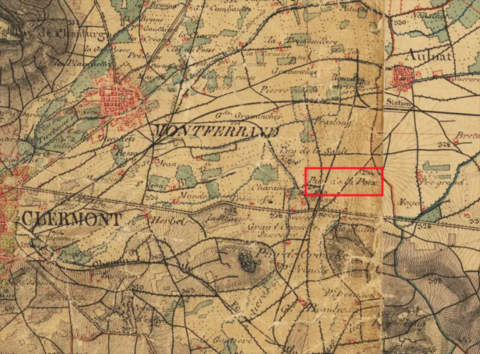Le Puy de la Poix : A geological and historical curiosity unique in Europe
Puy de la Poix, located to the north-east of Puy de Crouel, near Clermont-Aulnat airport, is a modest peperitic mound some three metres high. Despite its unassuming appearance, the site features a remarkable singularity : a “source” of natural hydrocarbons forming a stream of bitumen almost thirty meters long, a phenomenon unique in Europe.
An exceptional geological site
Bitumen escapes from a small cavity one meter in diameter and at least 40 cm deep. Mixed with salt water, this blackish material rises through fractures in the underlying peperite. This process is fed by hydrocarbons contained in Limagne's Oligocene sediments, which are rich in transformed organic matter. These hydrocarbons, less dense than the water and surrounding rocks, rise along faults or volcanic vents to reach the surface.
The flow rate is extremely low, estimated in the 19th century at around 1 liter per day, making industrial exploitation impossible. The spring is accompanied by particularly concentrated saline water, containing up to 83 g/L of various salts, mainly sodium chloride, a characteristic linked to the region's evaporitic deposits.
The mineralogical riches of Puy de la Poix
In addition to its hydrocarbons, the site is home to some fascinating mineral formations. Blue-gray chalcedony globules (lussatite) associated with ankerite crystals (described as giobertite by Gonnard in 1887) can be found in cracks in the peperite. These saltwater-penetrated siliceous orbicules may also be accompanied by natrolite, calcite, gypsum and pyrite. Although these mineralizations were described by researchers such as Alfred Lacroix at the end of the 19th century, they remain rare and difficult to observe today.
Human exploitation dating back to Antiquity
Puy de la Poix was known to the Gallo-Romans, who used bitumen for its binding and waterproofing properties. Although production has always been limited, it was enough to attract the attention of naturalists and kings, such as Charles IX, who visited the site in the 16th century. Various archaeological artefacts, including a menhir, testify to human occupation since the Bronze Age. The latter was knocked down by the Germans during the Second World War, who installed a flak turret to shoot down Allied aircraft.
Decline and oblivion
Despite various attempts to protect the site up until the end of the 19th century, Puy de la Poix has fallen into neglect and decline, surrounded by transport infrastructures (freeway and airport). Between 2009 and 2012, the Conservatoire des Espaces Naturels d'Auvergne and the city of Clermont-Ferrand undertook work to clear and enhance the site, including the installation of an explanatory enameled lava plaque. However, the site remains little known and poorly maintained, and even the name “Puy de la Poix” has disappeared from contemporary IGN and BRGM maps.
A natural heritage worth preserving
The Puy de la Poix is a unique curiosity that deserves greater recognition and protection. This once prestigious site is now threatened by indifference and human activity. It is a perfect illustration of the importance of promoting and preserving our geological heritage, not only for its beauty and uniqueness, but also for the historical and scientific wealth it embodies.
In comparison, similar sites such as those in California have been developed and protected, demonstrating the potential for better management of these natural treasures. Puy de la Poix could become an emblematic example of the conservation and enhancement of France's geological heritage.
References :
BORNET, R. (2009). La lussatite, une variété microcristalline de silice. TER Université Blaise Pascal de Clermont-Ferrand.
Collectif. (2015). La lussatite, l’opale d’Auvergne et autres trésors de la Limagne (Puy-de-Dôme). Hors-série n°21 de la revue Le Règne Minéral. Éditions du Piat, 84 pages
Planet-Terre. (2008). Source et ruisseau d'hydrocarbures, Puy de la Poix, Limagne de Clermont-Ferrand (Puy de Dôme). Planet-Terre, ENS de Lyon.



